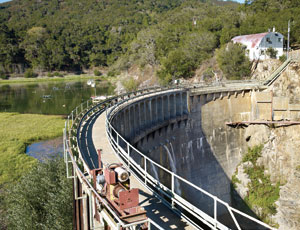Funding will be the key to one of the largest dam removal projects in California history.
State government officials and the California American Water Co. agreed on Jan. 11 to remove the 106-ft-tall San Clemente Dam on the Carmel River in Monterey County. The concrete arch dam, built in 1921, once provided drinking water to Monterey Peninsula residents, but its reservoir has since silted up 90%. In 1991, state dam inspectors also concluded the dam risked failure in a significant earthquake or flood event, which could release an estimated 2.5 million cu yds of sediment and more than 40 million gallons of water.

In the agreement, CalAm, which owns the dam and surrounding 900 acres, will work with the National Oceanic and Atmospheric Administration (NOAA) and the California State Coastal Conservancy, along with other state, federal and private organizations, to come up with the project plan, which also calls for the rerouting of the Carmel River.
The project cost is $84 million, according to CalAm spokeswoman Catherine Bowie. Monterey-based CalAm is pledging to provide $50 million.
The goal of the project’s first phase, which is scheduled to begin in 2013, will be to strengthen the dam to standards required by the state Division of Safety of Dams, Dept. of Water Resources. The next phases, which would occur over the following three dry-period years, will be to buttress the sentiment, remove the dam and divert the river, Bowie says.
Trish Chatman, project specialist for the State Coastal Conservancy in Oakland, which, along with the NOAA, is ponying up the other $34 million, says the state’s financial situation is a “challenge” to securing the project funding, but “we are quite optimistic that we will be able to do it.”
Chatman says there is a strong state commitment in favor of completing this project.
The conservancy expects state funding to come from bonds and grants that have already been approved and appropriated. Chatman says, however, that the funding is in place “in theory, but [state] agencies are currently restricted about the commitments they can make, and cash flow is very constrained.”
Chatman says the current project schedule anticipates having the money committed by spring 2012, and if the funding is not there by then, the construction start date could be pushed back.
Environmentalists are also in favor of the dam removal, which would aid in the recovery of steelhead trout by opening up access to 25 sq mi of spawning and rearing habitat. Steelhead in the Carmel River were listed in 1997 as threatened under the Endangered Species Act.


Post a comment to this article
Report Abusive Comment